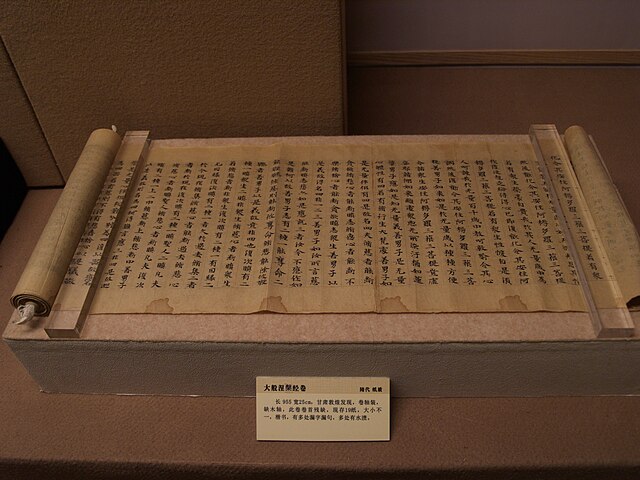Mahāyāna Mahāparinirvāṇa Sūtra
The Mahāyāna Mahāparinirvāṇa Sūtra or Nirvana Sutra for short, is an influential Mahāyāna Buddhist scripture of the Buddha-nature class. The original title of the sutra was Mahāparinirvāṇamahāsūtra and the earliest version of the text was associated with the Mahāsāṃghika-Lokottaravāda school. The sutra was particularly important for the development of East Asian Buddhism.
A Sui dynasty manuscript of the Nirvāṇa Sūtra
Cave complex associated with the Mahāsāṃghika sect. Karla Caves, Mahārāṣtra, India
Illustration of a chaitya cave temple, Karla Caves
Parinirvana scene in schist, Kushan dynasty, late 2nd to early 3rd century CE, Gandhara.
In Buddhist philosophy, Buddha-nature is the potential for all sentient beings to become a Buddha or the fact that all beings already have a pure buddha-essence within. "Buddha-nature" is the common English translation for several related Mahayana Buddhist terms, most notably tathāgatagarbha and buddhadhātu, but also sugatagarbha, and buddhagarbha. Tathāgatagarbha can mean "the womb" or "embryo" (garbha) of the "thus-gone one" (tathāgata), and can also mean "containing a tathāgata". Buddhadhātu can mean "buddha-element," "buddha-realm" or "buddha-substrate".
The moon hidden by the clouds is a metaphor for Buddha-nature which is always shining but can be hidden or covered over by the afflictions.
The Tathāgatagarbha Sūtra states that the tathāgatagarbha is like the grain of rice contained inside of the husk of the rice plant
The Tathāgatagarbha Sūtra uses the image of a Buddha within a lotus flower as a metaphor for the tathāgatagarbha
A ritual vajra, a symbol of indestructibility, which is used in the Ratnagotravibhāga as an image of the adamantine-like permanence of buddha nature.








